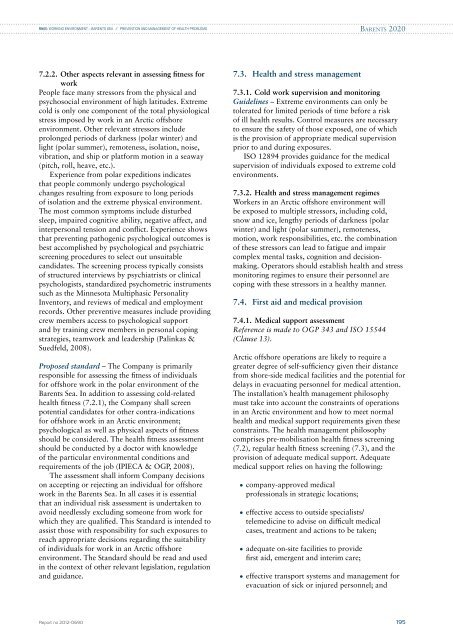phase 4 report - DNV
phase 4 report - DNV
phase 4 report - DNV
You also want an ePaper? Increase the reach of your titles
YUMPU automatically turns print PDFs into web optimized ePapers that Google loves.
RN05: WORKING ENVIRONMENT – BARENTS SEA // Prevention and management of health problemsBarents 20207.2.2. Other aspects relevant in assessing fitness forworkPeople face many stressors from the physical andpsychosocial environment of high latitudes. Extremecold is only one component of the total physiologicalstress imposed by work in an Arctic offshoreenvironment. Other relevant stressors includeprolonged periods of darkness (polar winter) andlight (polar summer), remoteness, isolation, noise,vibration, and ship or platform motion in a seaway(pitch, roll, heave, etc.).Experience from polar expeditions indicatesthat people commonly undergo psychologicalchanges resulting from exposure to long periodsof isolation and the extreme physical environment.The most common symptoms include disturbedsleep, impaired cognitive ability, negative affect, andinterpersonal tension and conflict. Experience showsthat preventing pathogenic psychological outcomes isbest accomplished by psychological and psychiatricscreening procedures to select out unsuitablecandidates. The screening process typically consistsof structured interviews by psychiatrists or clinicalpsychologists, standardized psychometric instrumentssuch as the Minnesota Multiphasic PersonalityInventory, and reviews of medical and employmentrecords. Other preventive measures include providingcrew members access to psychological supportand by training crew members in personal copingstrategies, teamwork and leadership (Palinkas &Suedfeld, 2008).Proposed standard – The Company is primarilyresponsible for assessing the fitness of individualsfor offshore work in the polar environment of theBarents Sea. In addition to assessing cold-relatedhealth fitness (7.2.1), the Company shall screenpotential candidates for other contra-indicationsfor offshore work in an Arctic environment;psychological as well as physical aspects of fitnessshould be considered. The health fitness assessmentshould be conducted by a doctor with knowledgeof the particular environmental conditions andrequirements of the job (IPIECA & OGP, 2008).The assessment shall inform Company decisionson accepting or rejecting an individual for offshorework in the Barents Sea. In all cases it is essentialthat an individual risk assessment is undertaken toavoid needlessly excluding someone from work forwhich they are qualified. This Standard is intended toassist those with responsibility for such exposures toreach appropriate decisions regarding the suitabilityof individuals for work in an Arctic offshoreenvironment. The Standard should be read and usedin the context of other relevant legislation, regulationand guidance.7.3. Health and stress management7.3.1. Cold work supervision and monitoringGuidelines – Extreme environments can only betolerated for limited periods of time before a riskof ill health results. Control measures are necessaryto ensure the safety of those exposed, one of whichis the provision of appropriate medical supervisionprior to and during exposures.ISO 12894 provides guidance for the medicalsupervision of individuals exposed to extreme coldenvironments.7.3.2. Health and stress management regimesWorkers in an Arctic offshore environment willbe exposed to multiple stressors, including cold,snow and ice, lengthy periods of darkness (polarwinter) and light (polar summer), remoteness,motion, work responsibilities, etc. the combinationof these stressors can lead to fatigue and impaircomplex mental tasks, cognition and decisionmaking.Operators should establish health and stressmonitoring regimes to ensure their personnel arecoping with these stressors in a healthy manner.7.4. First aid and medical provision7.4.1. Medical support assessmentReference is made to OGP 343 and ISO 15544(Clause 13).Arctic offshore operations are likely to require agreater degree of self-sufficiency given their distancefrom shore-side medical facilities and the potential fordelays in evacuating personnel for medical attention.The installation’s health management philosophymust take into account the constraints of operationsin an Arctic environment and how to meet normalhealth and medical support requirements given theseconstraints. The health management philosophycomprises pre-mobilisation health fitness screening(7.2), regular health fitness screening (7.3), and theprovision of adequate medical support. Adequatemedical support relies on having the following:• company-approved medicalprofessionals in strategic locations;• effective access to outside specialists/telemedicine to advise on difficult medicalcases, treatment and actions to be taken;• adequate on-site facilities to providefirst aid, emergent and interim care;• effective transport systems and management forevacuation of sick or injured personnel; andReport no 2012-0690 195






![Risk Based Pipeline Integrity Management [Compatibility Mode] - DNV](https://img.yumpu.com/50424229/1/190x146/risk-based-pipeline-integrity-management-compatibility-mode-dnv.jpg?quality=85)









